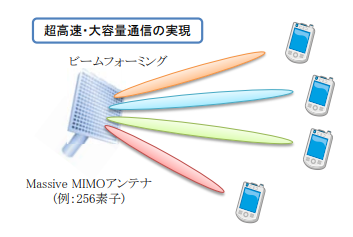Essential technology for millimeter-wave communication: Massive MIMO and AiP
This time, we will talk about 5G’s key technology, Massive MIMO and its associated implementation technology, Antenna in Package.
In the eMBB (enhanced Mobile BroadBand) scenario, the target for high-speed and high-capacity 5G communication speeds is 20Gbps at peak downstream and 10Gbps at peak upstream. This is 20 times the communication speed of the 4G (LTE-Advanced) target that is currently in the popularization stage. Millimeter-wave communication is said to be essential to achieve this.
However, the radio wave sibetween millimeterwaves has a higher attenuation rate than the lower frequency of radio waves, and there is a disadvantage that it is difficult to increase the transmission distance. In addition, because of the high frequency, the straightness is high, and there is a disadvantage that radio waves are easily blocked when there is an obstacle. In other words, in the millimeter wave band, the area that can be transmitted is reduced, and there is a high possibility that the place where the radio wave does not reach occurs.
To solve this problem, 5G uses a technology called Massive MIMO. To put it simply, this is a form of beamforming technology added to MIMO.
MIMO stands for Multiple input Multiple output, a technology that uses multiple antennas on both the sender and receiver to simultaneously communicate in the same frequency band and improve the quality and efficiency of communication. MIMO has already been put to practical use in WiFi and 4G, but the number of antennas was two to four inputs and outputs.
However, as can be seen from Massive (large scale), Massive MIMO adopted in 5G can mount up to 256 antenna elements and 32 antenna elements in user terminals such as smartphones. These antenna elements will be centrally placed in a flat array. By adaptively controlling these array-like antennas, beamforming is performed to increase the directivity of the emitted radio waves in a particular direction and to compensate for the loss of radio transmission.

Many semiconductor devices and electronic components are needed to realize Massive MIMO. These parts will also be provided as integrated modules rather than individual elements. These include RF front-end modules that integrate various RF front-end devices such as power amplifiers (PAs) and low noise amplifiers (LNa), and antenna array-mounted antenna arrays with a large number of antenna elements.
In addition, the demand for base stations of the type called small cells is expected to increase in 5G. Since 5G narrows the communication area that a single base station can cover, many small cells are required in addition to the base station called the conventional macrocell. Massive MIMO will be needed for this small cell.

5G (Source: Ministry of Internal Affairs and Communications of Japan)
There is also a major change in the mounting technology for practical use of Massive MIMO, which uses a large number of antenna elements. In the millimeter wave band, the transmission loss of the signal between the antenna module and the RF front-end module is remarkable, so it is necessary to place both as close as possible.
By the way, since the size of the antenna element is proportional to the wavelength of the carrier, the millimeter wave band can make the size of each antenna element very small. Therefore, by laminating array-like antenna elements with RF front-end modules and mounting them in a single package, the practical application of AiP (Antenna in Package), which can reduce signal transmission loss, is recommended.
For smartphone terminals, Qualcomm has already commercialized the QTM052, which combines a millimeter-wave RF front end and antenna module. AiP implementation services seem to have started at Amkor, a major OSAT company. In addition to Murata which already announced the mass production, TDK and Fujikura are developing these technologies in Japanese companies.
We will continue to focus on trends in the future.


